A 1974 Morris Marina commercial rarity
Posted by Chris Graham on 28th July 2022
Mike Neale meets Tony Page and enjoys a closer look at one of his 14 – yes, fourteen – Morris Marina commercials.
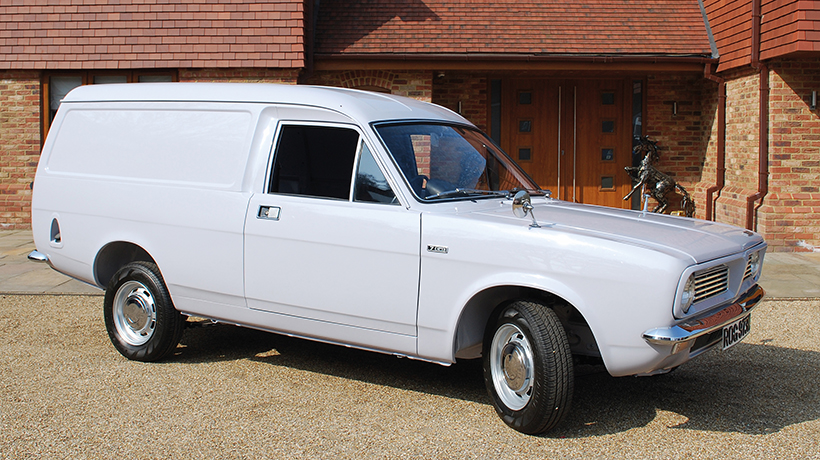
One of Tony Page’s 14 Morris Marina commercials.
The Morris Marina cars were hurriedly developed following the formation in 1968 of British Leyland, created by the merger of the Leyland Motor Corporation (which by then included Standard-Triumph and Rover) and British Motor Holdings (formed by the merger of BMC and Jaguar/Daimler in 1966). Design input came from Roy Haynes and then Harris Mann as well as Harry Webster.
The new British Leyland management urgently needed a car to challenge the Ford Escort and Cortina in the fleet market and to replace the Morris Minor and Oxford ranges, both of which were now totally outclassed. Yes, there was a full range of BMC/BL front wheel drive cars, but many fleet buyers considered these too high-tech and preferred conventional rear wheel drive simplicity.
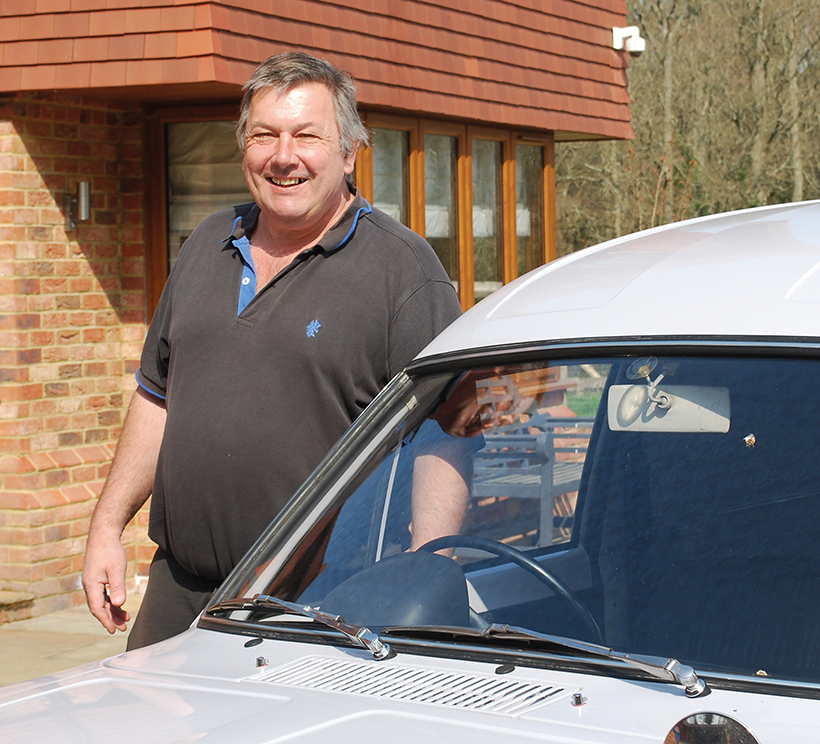
Owner, and Marina van collector extraordinaire, Tony Page.
The Marina was sized between the Minor and the Oxford, produced as a two-door fastback coupé or four-door saloon, with a choice of the 1.3-litre A-Series or 1.8-litre B-Series engine. Marina production was never intended to last more than five or six years – until a more permanent replacement could be put into production.
The plan had been to launch the Marina at the Earl’s Court Motor Show in October 1970, but that was too much of a rush, and it was instead presented to the motoring press in April 1971 at the Hotel Carlton in Cannes. The speed of development meant using a number of existing components from the corporate parts bin. Aside from the engines, the torsion-bar front suspension and lever-arm dampers were developed from the Minor, whilst the gearbox was a Triumph unit. The rush into production did result in a few issues, notably a massive understeer problem. All 1.8 cars had to be fitted with improved front suspension bottom joints before being sold.

The engine bay was designed for ease of access and maintenance. This is the optional 1,275cc engine – the commercials were also available with a 1,098cc unit that wasn’t offered in the cars.
Van and pickup versions were announced in August 1972, badged as either Morris or Austin (and later Austin-Morris). These replaced both the outgoing Minor ¼ ton LCV and the larger Austin A55 derived Austin/Morris ½ ton van/pick-up. Thus both 7cwt and 10cwt payload vans and a 10cwt pick-up were available, with a choice of either a 1,098cc or 1,275cc A-Series engine in the 7cwt. 1,275cc was standard in the 10cwt. This gave the Marina a competitive edge over the rival Ford Escort van, which was at the time offered only as a 6cwt or 8cwt and not as a pick-up.
Standard vans had a painted front bumper and cardboard door panels, whilst the deluxe had chrome front and rear bumpers, vinyl covered door panels, a heater, face-level vents and a passenger seat.
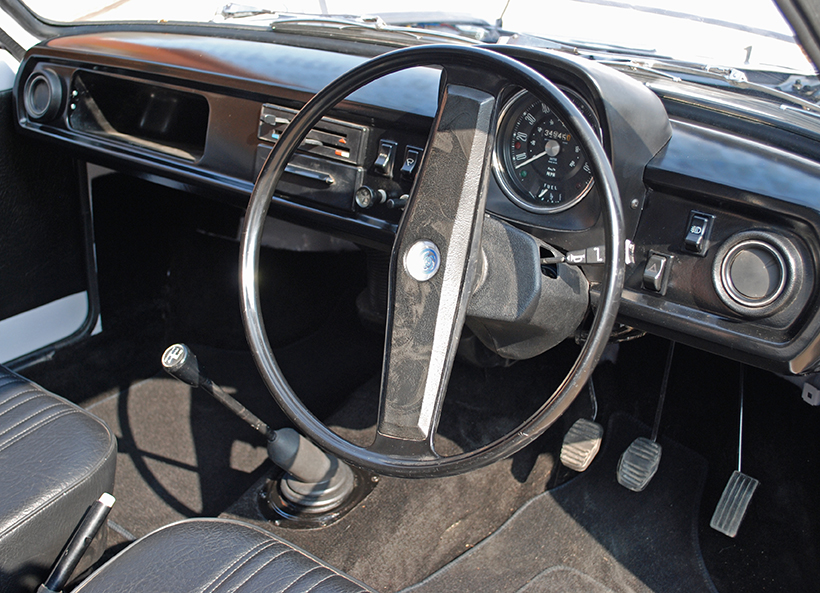
The dashboard – and cab area, generally – was a bit more basic than on the cars, but perfectly satisfactory.
An estate car was added in October 1972. The whole range was updated in October 1975 as the Marina Mk2, with a new grille design on the cars. The vans and pickups retained the Mk1 1.3 split type grille, however. Another mild restyle occurred in 1978 with the Mk3, whose grille was now also fitted to the commercials. The 7cwt became the Morris 440 and the 10cwt the Morris 575.
In 1980 the Marina was facelifted again to become the Morris Ital, including the commercials, with production ending in 1984. Over 1.3 million Marinas and Itals were produced over nearly 13 years, making it British Leyland’s best-selling car, though few now remain, and as usual, the commercial versions are especially rare.
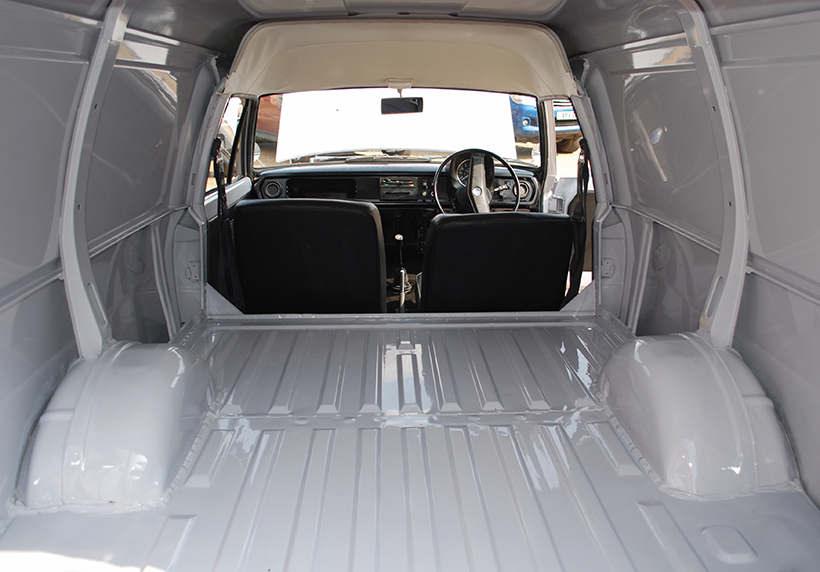
The now-immaculate loadspace. There’s 88cu.ft of room if a passenger seat was fitted, 104cu.ft if not.
One van that does is “Roger,” ROG 973M, a Marina 7cwt van with the optional 1,275cc engine, first registered in March 1974. It was bought new from BL dealership Thomas Startin Ltd. of Birmingham by a Geoffrey Browne, who owned Leopard Service Station in Birmingham, for use by the business. In 1990, Mr Browne transferred it into his own name for his personal use for a couple of years, then took it off the road.
It is now owned by serial Marina van collector Tony Page from Surrey, who bought it in 2014, to become its third registered keeper, but effectively only its second owner. At one time Tony had 40 Marinas in his collection, mostly commercials. Yes, you did read that right – Tony had FORTY Marina commercials.
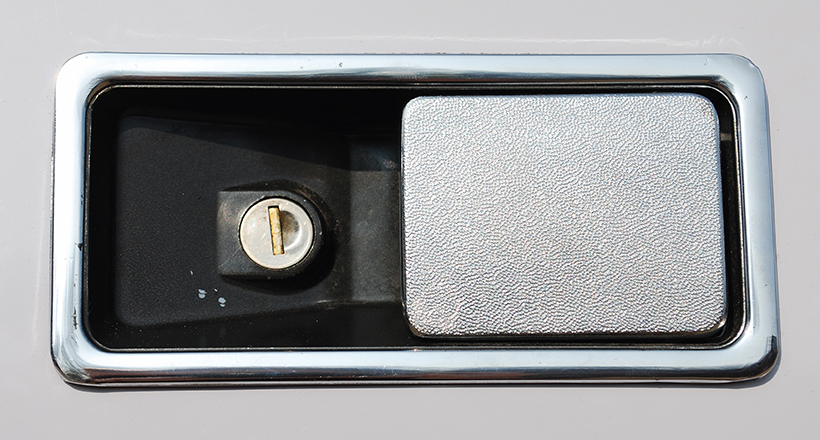
Familiar BL doorhandles were used on a wide range of vehicles from Marinas and Allegros to some Lotus sports cars! The handle part did, though, have a habit of breaking.
Tony explains. “I grew up on a farm and as a kid we always had Marina vans, whilst my mates all had Ford Escorts, so I have a soft spot for them. I had an ambition to get twelve Marina vans and pickups restored to how they left the factory, to display them all in a line-up. No-one else in the world would have that. Every time I saw one for sale I’d buy it, including vans that were only good for spares, ready for the grand restoration.”
He even went to Malta on holiday and bought two Marina vans on his first trip, as well as a load of spares, having been introduced to “The Marina man of Malta.” In all he has brought back five Maltese vans.
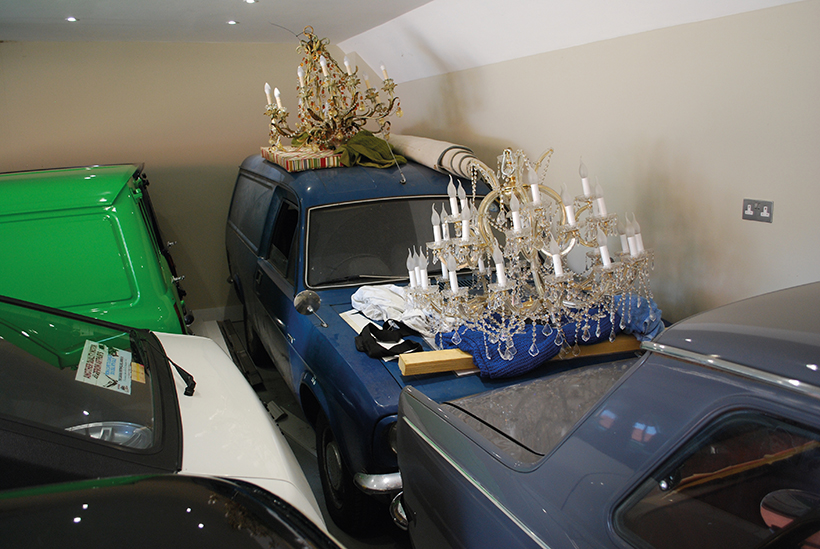
A corner of Tony’s storage facility, which Del and Rodney appear to be sharing! The blue van seen here is the oldest known survivor.
The first vehicle Tony decided to put through the restoration process was Roger. That was in 2015. The problem, was that there were no Marina restoration specialists.
“I wanted someone capable of doing the sort of quality you’d expect on an E-Type Jaguar restoration,” notes Tony. “I ended up approaching a Ford restoration specialist. He was interested in a Lotus-powered Mk1 Escort I had. He knew nothing about Marinas, but I gave him Roger as the first one to learn on and do at cost, so he could work out a price for the others. When it was done, as part payment he’d get the Escort.”
At least that was the theory. However, five years later, although the Marina had been stripped down, bodywork repaired and repainted, it was still in pieces in the workshop. Tony realised he was going to have to get the restoration completed elsewhere. After a “firm conversation,” he got the van back and paid for the work that had been done. “So, he never got the Escort, but we are still on good terms,” notes Tony.
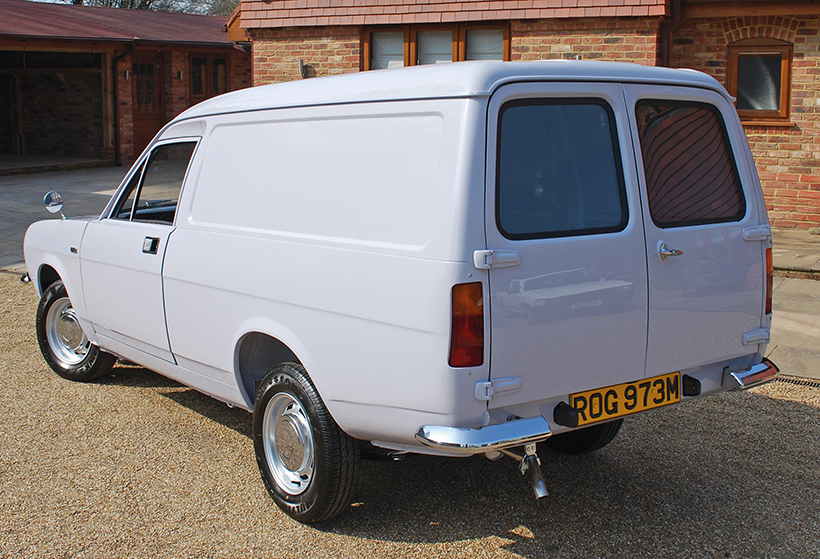
Rear view, showing deluxe-spec chrome quarter-bumpers.
He then approached Bob Hawkins of Hawkins Motorsport to do the rest of the work. “Bob mostly does race cars, but he worked on the production line at Cowley whilst Marinas were being built. He was, therefore, familiar with them and happy to take on a part-done project,” Tony tells me.
Bob finished the restoration in about six months. Tony notes that there are still a few minor details to do. “The back lights originally had a cardboard cover inside, so I’ve had two made ready to fit.”
The van was restored to original specification as far as possible, using New Old Stock parts where needed. For example, the front wings were replaced with NOS items, but fortunately the rest of the shell wasn’t too rusty. It has been resprayed in its original colour of Mirage Grey, albeit using two-pack paint. The wiring loom is the original, as is the engine, which has covered just 34,945 miles. Tony is an active member of the Morris Marina Owner’s Club, who have been supportive.
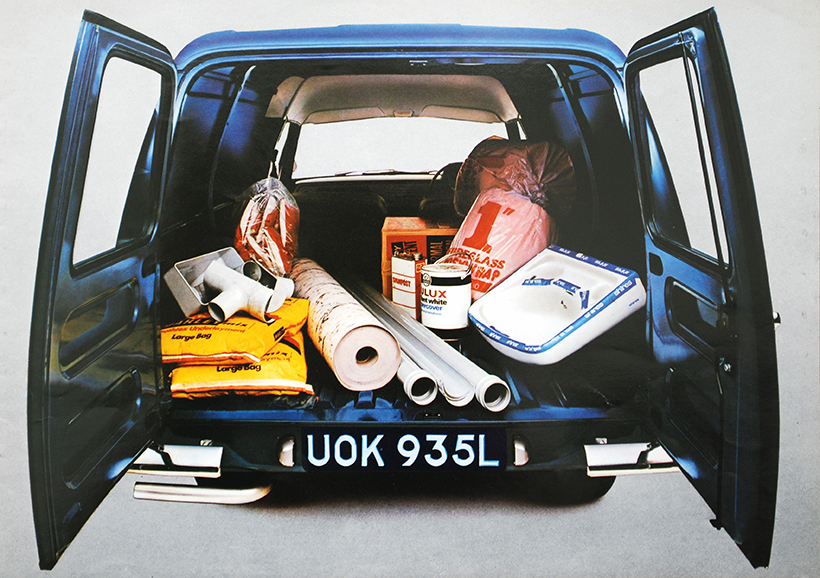
This image was included in the 1972 Austin brochure – though BMC had been formed 20 years previously, there was still a need for bespoke Austin and Morris versions, as the dealer networks still hadn’t fully integrated. Builder’s vans and building materials were never this clean!
Tony reckons the restoration ended up costing about £20,000. Putting a value on the finished van is difficult as they so rarely come up for sale. “I’ve suppressed the market for Marina vans for about 20 years, as I’ve bought them all,” laughs Tony. “I did turn down an offer of £10,000 for another Marina van I own, a 1973 1,098cc.”
In fact, he has started thinning out the collection, and now “only” has 14 Marina commercials, including the earliest known van, a 1972 UK supplied vehicle, as well as the second and third oldest known. The plan to have a line-up of 12 restored vans has now, reluctantly, been abandoned.
Roger will be trailered to car shows, but Tony is currently getting two others restored to use regularly, both 10cwt vans which are currently being painted. “The Marina saloons will outrun the commercials due to the latter’s lower gearing. The 1275cc van will do 65mph but it’s happier at 50-55mph. I’m going to fit 3.9:1 diffs to the two that are now being rebuilt to keep up with modern traffic better.” The 7cwt originally had a ratio of 4.111:1 and the 10cwt 4.556:1.
“The 7cwt vans had the same 13in. diameter wheels as the Marina saloons, whilst the 10cwt had wider wheels to suit the heavier weight, but still 13in. diameter. However, you can fit 15in. diameter wheels to the 10cwt axle with that stud pattern,” notes Tony.
Tony’s collection also includes a pair of Bedford J-Type pick-ups, Mk1 Transits, the Ford Capri and Daimler from the Minder TV series and a large number of motorbikes, amongst other vehicles and motoring memorabilia. However ,despite having such a varied collection, it’s the Marina commercials will always be at the heart of it.
This feature comes from the latest issue of Classic & Vintage Commercials, and you can get a money-saving subscription to this magazine simply by clicking HERE

Previous Post
1954 AEC Militant beautifully restored

Next Post
Classic and desirable Ford 7810 tractor profiled



